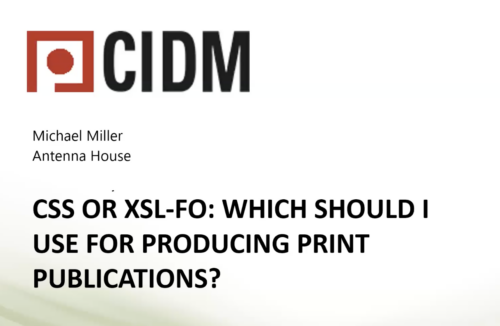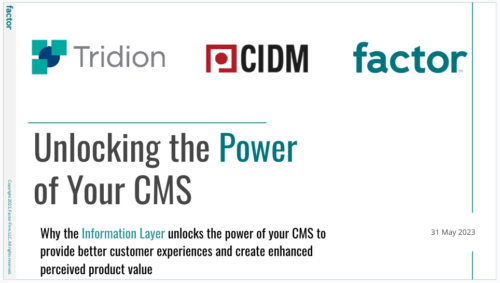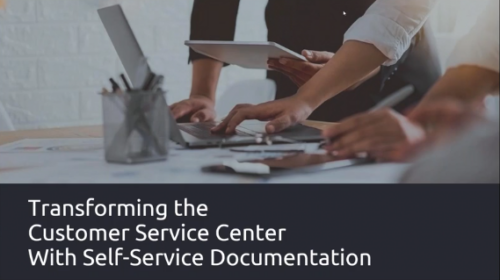Recorded on
June 21, 2023

Taxonomies and terminologies can be seen as different sides of the same coin. However, the focus is quite different. Taxonomies make linguistic data available for machines and humans to distill knowledge and often to manage chaos. Terminologies harmonize language, make sure everyone uses consistent and correct words, and try to avoid chaos from the outset. Organizations obviously require both, so it is only natural for Semantic Web Company and Kaleidoscope to integrate their two platforms and offer a combined taxonomy and terminology management solution.
This presentation and demo show you:
- how to connect your Pool Party taxonomy to the Kalcium terminology suite
- and add terminology benefits to your existing data:
- human-grade, rich metadata, organizational decision workflows, and automatic guidance in word choice for authors and translators alike
Presented by Klaus Fleischmann and Sebastian Gabler

Klaus Fleischmann studied translation and IT in Vienna, and holds an MA in Conference Interpreting from Monterey, California, and a MAS in Technical Communication from Krems, Austria. In 1996, he founded Austria-based Kaleidoscope, a company implementing content, translation, and terminology management processes for internationally active companies. Kaleidoscope develops online collaboration software for enterprise-level terminology workflow, translator query management, in-country review, etc., making the translation quality process comprehensible and strategically manageable. In 2007, he became CEO of Austria´s leading LSP, Eurocom Translation Services. Always active in the industry, Klaus got voted into the Gala Board of Directors in 2015 and 2017.
 Sebastian Gabler originally trained as a Recording Producer with a diploma from the Berlin University of the Arts (UdK) and 5 years of music production for radio, TV, and the recording industry; he has been pursuing a career in archive and information management for over 15 years
Sebastian Gabler originally trained as a Recording Producer with a diploma from the Berlin University of the Arts (UdK) and 5 years of music production for radio, TV, and the recording industry; he has been pursuing a career in archive and information management for over 15 years
In 2017, he joined Semantic Web Company in Vienna and was appointed Chief Customer Officer in 2020. In this position, he supports customers from all industries in developing intelligent applications with semantic AI. Sebastian has worked in various companies in the areas of technology, sales, and project management, including 11 years in the field of audiovisual archiving, and has recently completed his Master of Sciences in Library and Information Science.

 Large Language Models (LLMs) are a hot topic, discussed from many different angles. There is a lot of excitement about what they can do, but also a lot of concern about how they do it.
It's one thing to let generative AI write a poem or the description of a talk (not the case here), but can we trust it to give us the right answers to critical questions or make the right decisions? The clear disadvantages of this approach are the lack of explainability of the results, consistency, and accuracy of responses, the need for large amounts of high-quality data, and the potential for bias in the content generated by the models. One possible answer to these challenges is to combine these generative technologies with knowledge graphs that can help explain the results and support the generation of high-quality data to train the models. The combination of generative AI and symbolic AI can ultimately lead to eXplainable AI (XAI), which can help us in our daily work.
We will show the benefits of combining both technologies, how knowledge graphs and intelligent structured source content can help to create better and more explainable results with generative technologies, and how generative technologies can help to create better knowledge graphs. This combination will lead to the creation of intelligent content that enables deeper understanding and informed decision making.
Etteplan and Semantic Web Company have developed unparalleled experiences and capabilities in creating, developing, and maintaining consistent (technical) knowledge bases for many companies across multiple industries and markets - placing them in a unique position to leverage the true potential of Large Language Models.
Presented by:
Helmut Nagy, Semantic Web
Large Language Models (LLMs) are a hot topic, discussed from many different angles. There is a lot of excitement about what they can do, but also a lot of concern about how they do it.
It's one thing to let generative AI write a poem or the description of a talk (not the case here), but can we trust it to give us the right answers to critical questions or make the right decisions? The clear disadvantages of this approach are the lack of explainability of the results, consistency, and accuracy of responses, the need for large amounts of high-quality data, and the potential for bias in the content generated by the models. One possible answer to these challenges is to combine these generative technologies with knowledge graphs that can help explain the results and support the generation of high-quality data to train the models. The combination of generative AI and symbolic AI can ultimately lead to eXplainable AI (XAI), which can help us in our daily work.
We will show the benefits of combining both technologies, how knowledge graphs and intelligent structured source content can help to create better and more explainable results with generative technologies, and how generative technologies can help to create better knowledge graphs. This combination will lead to the creation of intelligent content that enables deeper understanding and informed decision making.
Etteplan and Semantic Web Company have developed unparalleled experiences and capabilities in creating, developing, and maintaining consistent (technical) knowledge bases for many companies across multiple industries and markets - placing them in a unique position to leverage the true potential of Large Language Models.
Presented by:
Helmut Nagy, Semantic Web
 Helmut is Chief Operating Officer of the Semantic Web Company (SWC). In his role as COO he designs and implements customer-centric processes and plans the strategic development of the PoolParty Semantic Suite together with the involved teams based on the SWC business strategy.
Eric Tengstrand, Etteplan
Helmut is Chief Operating Officer of the Semantic Web Company (SWC). In his role as COO he designs and implements customer-centric processes and plans the strategic development of the PoolParty Semantic Suite together with the involved teams based on the SWC business strategy.
Eric Tengstrand, Etteplan
 With over 10 years of experience in leading and developing service solutions for different customers within the manufacturing industry, Eric is currently the Vice President Global Service Solutions in Technical Communication Solutions at Etteplan.
Etteplan is a rapidly growing Technology Service company specializing in software and embedded solutions, engineering solutions, and technical communication solutions. We are a forerunner in the engineering industry and we differentiate ourselves by the wide-ranging competence of our experts. Our customers include the world’s leading companies in the manufacturing industry. We help them to create a better world through engineering, innovation, and digitalization. The company currently has over 4,000 professionals globally of which 850 are in Technical Communication Solutions.
Eric’s mission is to help Etteplan’s customers improve their operational performance and achieve their business goals through innovative and cost-effective managed services.
Eric is responsible for the strategic direction, offering development and solutions sales leading a team of professionals across 4 countries.
With over 10 years of experience in leading and developing service solutions for different customers within the manufacturing industry, Eric is currently the Vice President Global Service Solutions in Technical Communication Solutions at Etteplan.
Etteplan is a rapidly growing Technology Service company specializing in software and embedded solutions, engineering solutions, and technical communication solutions. We are a forerunner in the engineering industry and we differentiate ourselves by the wide-ranging competence of our experts. Our customers include the world’s leading companies in the manufacturing industry. We help them to create a better world through engineering, innovation, and digitalization. The company currently has over 4,000 professionals globally of which 850 are in Technical Communication Solutions.
Eric’s mission is to help Etteplan’s customers improve their operational performance and achieve their business goals through innovative and cost-effective managed services.
Eric is responsible for the strategic direction, offering development and solutions sales leading a team of professionals across 4 countries.










 Tristan is Product Director at DeltaXML, a technology company with world-leading software products for the management of change in structured content. He has a deep understanding of DeltaXML’s product suite and loves to help customers create extra value in their content using change management. Tristan is a father to three daughters, a movie lover, and a keen runner.
Tristan is Product Director at DeltaXML, a technology company with world-leading software products for the management of change in structured content. He has a deep understanding of DeltaXML’s product suite and loves to help customers create extra value in their content using change management. Tristan is a father to three daughters, a movie lover, and a keen runner.

 Stilo showcases a comprehensive, end-to-end process for converting pharmaceutical documentation, beginning with the source DOCX Word file. This journey encompasses the creation of automation rules, execution of the conversion, meticulous quality assurance, and, ultimately, the seamless publication of the final output through Oxygen. Explore how Stilo's Migrate effortlessly addresses prevalent conversion challenges, including the precise identification and generation of product name keys, resolution of table alignment discrepancies, and an array of other crucial tasks. Dive deep into the intricacies of transforming your industry-specific content from its initial state, ensuring a flawless and efficient transition.
Presented by: TJ Dhaliwal, Stilo
Stilo showcases a comprehensive, end-to-end process for converting pharmaceutical documentation, beginning with the source DOCX Word file. This journey encompasses the creation of automation rules, execution of the conversion, meticulous quality assurance, and, ultimately, the seamless publication of the final output through Oxygen. Explore how Stilo's Migrate effortlessly addresses prevalent conversion challenges, including the precise identification and generation of product name keys, resolution of table alignment discrepancies, and an array of other crucial tasks. Dive deep into the intricacies of transforming your industry-specific content from its initial state, ensuring a flawless and efficient transition.
Presented by: TJ Dhaliwal, Stilo
 TJ Dhaliwal is a Technical Sales Product Specialist at Stilo, helping customers uncover solutions to their content conversion needs. With a solid technical background in engineering and a passion for public speaking, he’s successfully bridged the gaps between project stakeholders. As a problem solver, TJ has helped several enterprise-level companies convert tens of thousands of pages of their content to DITA.
TJ Dhaliwal is a Technical Sales Product Specialist at Stilo, helping customers uncover solutions to their content conversion needs. With a solid technical background in engineering and a passion for public speaking, he’s successfully bridged the gaps between project stakeholders. As a problem solver, TJ has helped several enterprise-level companies convert tens of thousands of pages of their content to DITA.

 Klaus Fleischmann studied translation and IT in Vienna, holds an MA in Conference Interpreting from Monterey, California, and a MAS in Technical Communication from Krems, Austria. In 1996, he founded Austria-based Kaleidoscope, a company implementing content, translation, and terminology management processes for internationally active companies. Kaleidoscope develops online collaboration software for enterprise-level terminology workflow, translator query management, in-country review etc., making the translation quality process comprehensible and strategically manageable. In 2007, he became CEO of Austria´s leading LSP, Eurocom Translation Services. Always active in the industry, Klaus got voted into the Gala Board of Directors in 2015 and 2017
Klaus Fleischmann studied translation and IT in Vienna, holds an MA in Conference Interpreting from Monterey, California, and a MAS in Technical Communication from Krems, Austria. In 1996, he founded Austria-based Kaleidoscope, a company implementing content, translation, and terminology management processes for internationally active companies. Kaleidoscope develops online collaboration software for enterprise-level terminology workflow, translator query management, in-country review etc., making the translation quality process comprehensible and strategically manageable. In 2007, he became CEO of Austria´s leading LSP, Eurocom Translation Services. Always active in the industry, Klaus got voted into the Gala Board of Directors in 2015 and 2017
 Mikael Lundahl works with language processes and language technology. From content creation to translation and publishing. From marketing material to technical documentation and software strings. His focus is on how terminology, with processes and tools, can support both the writing and translation processes.
Fodina Language Technology partners with and sells products from Kaleidoscope and Acrolinx. But Fodina also develops tools that help customers to build their company terminologies based on existing documentation, standards, or competitor's web information. AI-supported term extraction from many file formats and automated clustering of identified terms into concepts. Through integrations to both Acrolinx and Kaleidoscope products, we have full tool support for the terminology process that we recommend customers to use. Our tools support working with terms in English, German, and Swedish.
Mikael Lundahl works with language processes and language technology. From content creation to translation and publishing. From marketing material to technical documentation and software strings. His focus is on how terminology, with processes and tools, can support both the writing and translation processes.
Fodina Language Technology partners with and sells products from Kaleidoscope and Acrolinx. But Fodina also develops tools that help customers to build their company terminologies based on existing documentation, standards, or competitor's web information. AI-supported term extraction from many file formats and automated clustering of identified terms into concepts. Through integrations to both Acrolinx and Kaleidoscope products, we have full tool support for the terminology process that we recommend customers to use. Our tools support working with terms in English, German, and Swedish.


 Fabrice Lacroix is a serial entrepreneur and a technology pioneer. He has been working for 25 years on the development of innovative solutions around search technology, content enrichment and AI. He is the founder of Fluid Topics, the leading Content Delivery Platform that reinvents how users search, read and interact with technical documentation.
Fabrice Lacroix is a serial entrepreneur and a technology pioneer. He has been working for 25 years on the development of innovative solutions around search technology, content enrichment and AI. He is the founder of Fluid Topics, the leading Content Delivery Platform that reinvents how users search, read and interact with technical documentation. 



 Christopher Hill is the Technical Product Manager for Harmonizer at Data Conversion Laboratory. Chris is an experienced IT professional who started programming in the 1980s. Since the early 2000s, Chris’ experience includes work as a support engineer, product manager, and user interface designer, helping organizations transition data and content to modern digital formats and platforms.
Christopher Hill is the Technical Product Manager for Harmonizer at Data Conversion Laboratory. Chris is an experienced IT professional who started programming in the 1980s. Since the early 2000s, Chris’ experience includes work as a support engineer, product manager, and user interface designer, helping organizations transition data and content to modern digital formats and platforms.


 Sebastian Gabler originally trained as a Recording Producer with a diploma from the Berlin University of the Arts (UdK) and 5 years of music production for radio, TV, and the recording industry; he has been pursuing a career in archive and information management for over 15 years
Sebastian Gabler originally trained as a Recording Producer with a diploma from the Berlin University of the Arts (UdK) and 5 years of music production for radio, TV, and the recording industry; he has been pursuing a career in archive and information management for over 15 years

 Daniel Nutburn is an accomplished executive and the Vice President of Global Partners and Alliances at Acrolinx. Daniel's got a wealth of experience in channel development, alliance management, and software solution selling. He's built an international partner network and has a solid track record of success with blue-chip and high-growth software companies.
Beyond his professional achievements, Dan is most proud of his ability to embarrass his daughters with his Karaoke singing and Cacti collection. LinkedIn:
Daniel Nutburn is an accomplished executive and the Vice President of Global Partners and Alliances at Acrolinx. Daniel's got a wealth of experience in channel development, alliance management, and software solution selling. He's built an international partner network and has a solid track record of success with blue-chip and high-growth software companies.
Beyond his professional achievements, Dan is most proud of his ability to embarrass his daughters with his Karaoke singing and Cacti collection. LinkedIn:  Jamila Elouazani is the Director of Partner Solutions, Global at Acrolinx, a leading content optimization technology for enterprise companies. With years of experience working in solution and product-focused environments, Jamila has honed her skills in providing technical support to businesses looking to close deals with Fortune 500 companies.
Jamila Elouazani is the Director of Partner Solutions, Global at Acrolinx, a leading content optimization technology for enterprise companies. With years of experience working in solution and product-focused environments, Jamila has honed her skills in providing technical support to businesses looking to close deals with Fortune 500 companies.

 Jacob Brennan is a Technical Sales Product Specialist at Stilo. He works with Stilo Migrate customers and aids in converting their legacy content to DITA. Jacob is a recent graduate from the University of Ottawa holding a BASc. in Mechanical Engineering and a BSc. in Computing Technology.
Jacob Brennan is a Technical Sales Product Specialist at Stilo. He works with Stilo Migrate customers and aids in converting their legacy content to DITA. Jacob is a recent graduate from the University of Ottawa holding a BASc. in Mechanical Engineering and a BSc. in Computing Technology. 

 Chip Gettinger is the VP of Global Solutions Consulting at RWS, he manages a team that works with customers in maximizing global content with RWS. He has experience working with customers to develop global content strategies, business ROI adoption drivers, change management, and technology adoption for component content management systems. He speaks and blogs about customer successes working closely with industry standards, partners, and customers in technology solutions and deployments.
with guests Bram Wessel and Bob Kasenchak, Factor Firm
Chip Gettinger is the VP of Global Solutions Consulting at RWS, he manages a team that works with customers in maximizing global content with RWS. He has experience working with customers to develop global content strategies, business ROI adoption drivers, change management, and technology adoption for component content management systems. He speaks and blogs about customer successes working closely with industry standards, partners, and customers in technology solutions and deployments.
with guests Bram Wessel and Bob Kasenchak, Factor Firm
 With more than two decades as a user-centered design and research professional, Bram Wessel believes that technology should enable natural experiences for real people. Bram has developed human-centered digital experience designs and strategies for such high-impact brands as Adobe, Amazon, Backcountry, the City of Seattle, Crate & Barrel, Disney, Expedia, GE, Group Health, Intel, Lionsgate, MasterCard, Microsoft, Nordstrom, Real, Safeco, Sony, Starbucks, Volvo, UW Medicine, and Warner Brothers.
A tireless advocate for the IA/UX discipline, with many articles to his credit, Bram is a frequent speaker at conferences such as the Information Architecture Summit, UX Week, Lavacon, Webvisions, ConveyUX, Seattle Design Festival, Taxonomy Bootcamp, and regional meetups and workshops. He is committed to educating the next generation of practitioners through his advanced User Experience and certificate Information Architecture classes at the School of Visual Concepts and as a guest lecturer at the University of Washington’s MCDM and MLIS programs.
Bram is a member of the Information Architecture Institute (IAI) and the Seattle chapter of the international Interaction Design Association (IxDA). Bram is a founding partner at Factor. In his spare time, Bram enjoys fly-fishing. shellfish farming, and making wine.
With more than two decades as a user-centered design and research professional, Bram Wessel believes that technology should enable natural experiences for real people. Bram has developed human-centered digital experience designs and strategies for such high-impact brands as Adobe, Amazon, Backcountry, the City of Seattle, Crate & Barrel, Disney, Expedia, GE, Group Health, Intel, Lionsgate, MasterCard, Microsoft, Nordstrom, Real, Safeco, Sony, Starbucks, Volvo, UW Medicine, and Warner Brothers.
A tireless advocate for the IA/UX discipline, with many articles to his credit, Bram is a frequent speaker at conferences such as the Information Architecture Summit, UX Week, Lavacon, Webvisions, ConveyUX, Seattle Design Festival, Taxonomy Bootcamp, and regional meetups and workshops. He is committed to educating the next generation of practitioners through his advanced User Experience and certificate Information Architecture classes at the School of Visual Concepts and as a guest lecturer at the University of Washington’s MCDM and MLIS programs.
Bram is a member of the Information Architecture Institute (IAI) and the Seattle chapter of the international Interaction Design Association (IxDA). Bram is a founding partner at Factor. In his spare time, Bram enjoys fly-fishing. shellfish farming, and making wine.


 Fabrice Lacroix is a serial entrepreneur and a technology pioneer. He has been working for 25 years on the development of innovative solutions around search technology, content enrichment and AI. He is the founder of Fluid Topics, the leading Content Delivery Platform that reinvents how users search, read and interact with technical documentation.
Fabrice Lacroix is a serial entrepreneur and a technology pioneer. He has been working for 25 years on the development of innovative solutions around search technology, content enrichment and AI. He is the founder of Fluid Topics, the leading Content Delivery Platform that reinvents how users search, read and interact with technical documentation. 
 Wiegert Tierie is Vice President of Strategic Accounts and Tridion America Sales Team Lead. He brings over 25 years of experience in numerous senior leadership roles. He is an ambitious visionary executive that uniquely combines strategy, sales, and marketing experience with an extensive background in financial, business process optimization, and product management to offer our customers a competitive edge, building their brand and their go-to-market strategy. To deliver results and success for the key customers he works with. Earlier Wiegert worked with Tridion, the leading Dutch Customer Experience and WCM vendor, and successfully launched numerous projects with Marquee brands. Prior to that, he played a key role in the introduction of Adobe Acrobat in Europe. Wiegert earned a Master of Science in Business from the University of Groningen (The Netherlands). He loves the outdoors, sailing and currently lives near St. Petersburg FL (he moved from San Francisco, CA in May 2020)
Wiegert Tierie is Vice President of Strategic Accounts and Tridion America Sales Team Lead. He brings over 25 years of experience in numerous senior leadership roles. He is an ambitious visionary executive that uniquely combines strategy, sales, and marketing experience with an extensive background in financial, business process optimization, and product management to offer our customers a competitive edge, building their brand and their go-to-market strategy. To deliver results and success for the key customers he works with. Earlier Wiegert worked with Tridion, the leading Dutch Customer Experience and WCM vendor, and successfully launched numerous projects with Marquee brands. Prior to that, he played a key role in the introduction of Adobe Acrobat in Europe. Wiegert earned a Master of Science in Business from the University of Groningen (The Netherlands). He loves the outdoors, sailing and currently lives near St. Petersburg FL (he moved from San Francisco, CA in May 2020)
 Wouter Maagdenberg is CEO and Cofounder of TXTOmedia. He is a serial entrepreneur who started his first tech company, during his BA studies at Erasmus University in 1996.
Wouter Maagdenberg is CEO and Cofounder of TXTOmedia. He is a serial entrepreneur who started his first tech company, during his BA studies at Erasmus University in 1996.

 Paul Bongers is a strategist, technologist, and a SaaS generalist. In his role as VP Strategy, Paul shapes the Acrolinx product strategy. His team works closely with all departments across the business to foster innovation and expand value for Acrolinx customers.
LinkedIn:
Paul Bongers is a strategist, technologist, and a SaaS generalist. In his role as VP Strategy, Paul shapes the Acrolinx product strategy. His team works closely with all departments across the business to foster innovation and expand value for Acrolinx customers.
LinkedIn: 


 Alex Masycheff is the CEO of Intuillion Ltd. (
Alex Masycheff is the CEO of Intuillion Ltd. (



 Amber Swope is an internationally recognized Information Architect, Darwin Information Typing Architecture (DITA) expert, and information architecture (IA) consultant. With over 20 years of information development experience and 15 years of DITA expertise, Amber specializes in helping organizations create opportunity through IA. She helps teams build scalable IA solutions to future-enable their content and empowers team members to advance their architecture as it evolves to meet new business needs.
Amber Swope is an internationally recognized Information Architect, Darwin Information Typing Architecture (DITA) expert, and information architecture (IA) consultant. With over 20 years of information development experience and 15 years of DITA expertise, Amber specializes in helping organizations create opportunity through IA. She helps teams build scalable IA solutions to future-enable their content and empowers team members to advance their architecture as it evolves to meet new business needs.